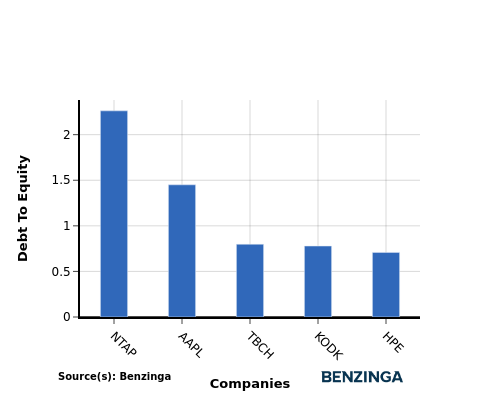In the ever-evolving and intensely competitive business landscape, conducting a thorough company analysis is of utmost importance for investors and industry followers. In this article, we will carry out an in-depth industry comparison, assessing Apple AAPL alongside its primary competitors in the Technology Hardware, Storage & Peripherals industry. By meticulously examining key financial metrics, market positioning, and growth prospects, we aim to offer valuable insights to investors and shed light on company's performance within the industry.
Apple Background
Apple is among the largest companies in the world, with a broad portfolio of hardware and software products targeted at consumers and businesses. Apple's iPhone makes up a majority of the firm sales, and Apple's other products like Mac, iPad, and Watch are designed around the iPhone as the focal point of an expansive software ecosystem. Apple has progressively worked to add new applications, like streaming video, subscription bundles, and augmented reality. The firm designs its own software and semiconductors while working with subcontractors like Foxconn and TSMC to build its products and chips. Slightly less than half of Apple's sales come directly through its flagship stores, with a majority of sales coming indirectly through partnerships and distribution.
| Company | P/E | P/B | P/S | ROE | EBITDA (in billions) | Gross Profit (in billions) | Revenue Growth |
|---|---|---|---|---|---|---|---|
| Apple Inc | 35.54 | 50.38 | 8.66 | 58.74% | $45.91 | $58.27 | 3.95% |
| Hewlett Packard Enterprise Co | 7.75 | 0.84 | 0.70 | 2.39% | $1.11 | $2.29 | 16.27% |
| Super Micro Computer Inc | 15.26 | 3.34 | 1.07 | 5.29% | $0.4 | $0.67 | 54.93% |
| NetApp Inc | 16.76 | 18.77 | 2.93 | 31.69% | $0.45 | $1.15 | 2.18% |
| Pure Storage Inc | 148.42 | 11.48 | 4.98 | 3.12% | $0.09 | $0.59 | 11.4% |
| Western Digital Corp | 12.08 | 1.20 | 0.92 | 4.89% | $0.96 | $1.52 | 41.33% |
| Eastman Kodak Co | 6.96 | 0.79 | 0.55 | 2.46% | $0.05 | $0.05 | -3.27% |
| Turtle Beach Corp | 19.31 | 2.49 | 0.84 | 18.11% | $0.03 | $0.05 | 46.76% |
| AstroNova Inc | 17.53 | 0.73 | 0.44 | 0.26% | $0.0 | $0.01 | 7.65% |
| Average | 30.51 | 4.96 | 1.55 | 8.53% | $0.39 | $0.79 | 22.16% |
Upon a comprehensive analysis of Apple, the following trends can be discerned:
-
The Price to Earnings ratio of 35.54 for this company is 1.16x above the industry average, indicating a premium valuation associated with the stock.
-
It could be trading at a premium in relation to its book value, as indicated by its Price to Book ratio of 50.38 which exceeds the industry average by 10.16x.
-
With a relatively high Price to Sales ratio of 8.66, which is 5.59x the industry average, the stock might be considered overvalued based on sales performance.
-
With a Return on Equity (ROE) of 58.74% that is 50.21% above the industry average, it appears that the company exhibits efficient use of equity to generate profits.
-
The company exhibits higher Earnings Before Interest, Taxes, Depreciation, and Amortization (EBITDA) of $45.91 Billion, which is 117.72x above the industry average, implying stronger profitability and robust cash flow generation.
-
The company has higher gross profit of $58.27 Billion, which indicates 73.76x above the industry average, indicating stronger profitability and higher earnings from its core operations.
-
With a revenue growth of 3.95%, which is much lower than the industry average of 22.16%, the company is experiencing a notable slowdown in sales expansion.
Debt To Equity Ratio

The debt-to-equity (D/E) ratio is a financial metric that helps determine the level of financial risk associated with a company's capital structure.
Considering the debt-to-equity ratio in industry comparisons allows for a concise evaluation of a company's financial health and risk profile, aiding in informed decision-making.
By evaluating Apple against its top 4 peers in terms of the Debt-to-Equity ratio, the following observations arise:
-
Apple is positioned in the middle in terms of the debt-to-equity ratio compared to its top 4 peers.
-
This suggests a balanced financial structure, where the company maintains a moderate level of debt while also relying on equity financing with a debt-to-equity ratio of 1.45.
Key Takeaways
For Apple in the Technology Hardware, Storage & Peripherals industry, the PE, PB, and PS ratios are all high compared to peers, indicating a potentially overvalued stock. On the other hand, Apple's high ROE, EBITDA, gross profit, and low revenue growth suggest strong profitability and operational efficiency relative to industry competitors.
This article was generated by Benzinga's automated content engine and reviewed by an editor.
Edge Rankings
Price Trend
© 2025 Benzinga.com. Benzinga does not provide investment advice. All rights reserved.
Trade confidently with insights and alerts from analyst ratings, free reports and breaking news that affects the stocks you care about.